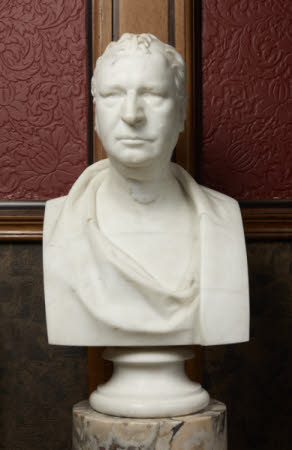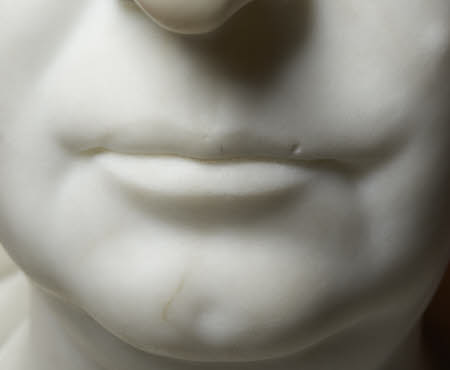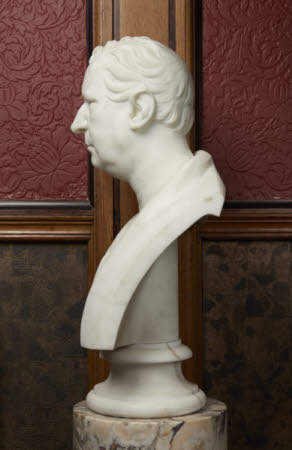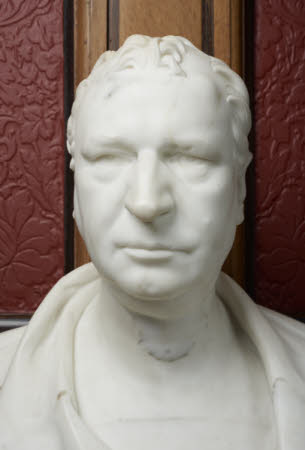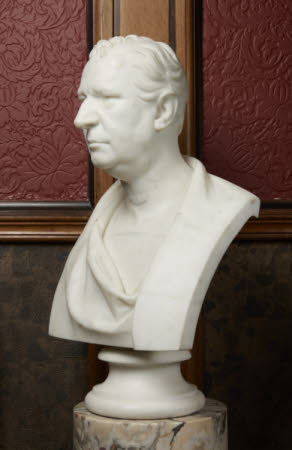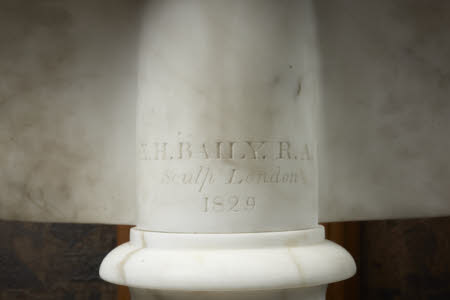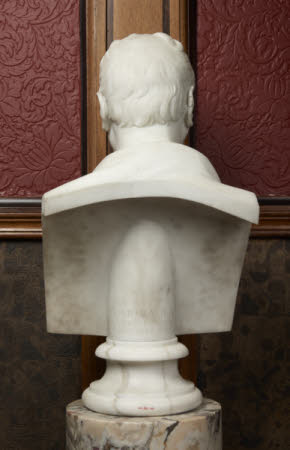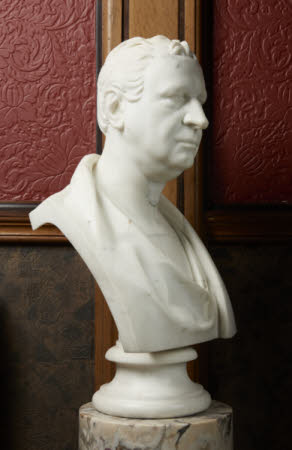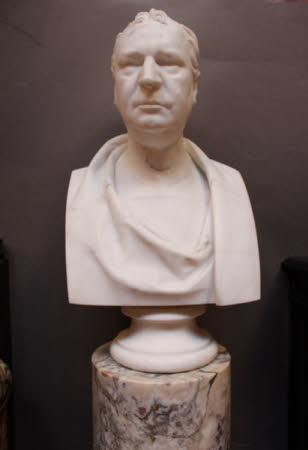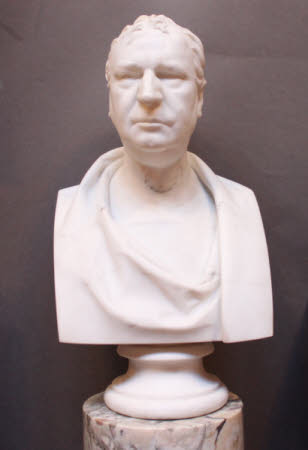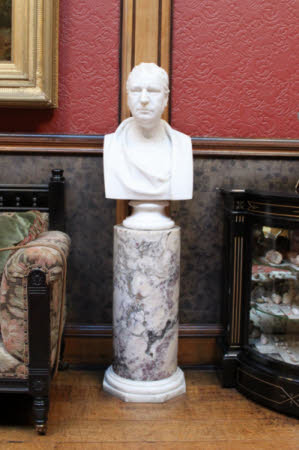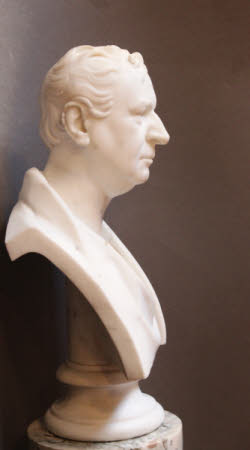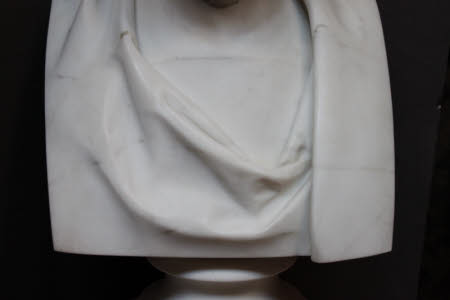Portrait bust of Armorer Donkin
Edward Hodges Baily (Bristol 1788 - London 1867)
Category
Art / Sculpture
Date
1829
Materials
Marble
Measurements
660 mm (H)685 mm (H)350 mm (Diameter)
Place of origin
London
Order this imageCollection
Cragside, Northumberland
NT 1231033
Summary
Sculpture, marble; portrait bust of Armorer Donkin (1779-1851); Edward Hodges Baily (1788-1867); 1829. A marble portrait bust of the Newcastle solicitor and businessman Armorer Donkin, a close friend of Sir William Armstrong’s father and of Sir William himself.
Full description
A marble portrait bust by Edward Hodges Baily (1788-1867) of Armorer Donkin. The bust is in the form of a herm with squared bust section, with loose classical drapery. The sitter is shown looking slightly to his right. On a turned marble socle; signed and dated on the back. Edward Hodges Baily was a successful sculptor who had a long career running throughout almost the whole of the first half of the nineteenth century. Today he is best-remembered for his colossal statue of Lord Nelson atop Nelson’s Column in Trafalgar Square, London, but in his lifetime his ideal figures were especially highly regarded, above all his Eve at the Fountain, of which a version of the head is also at Cragside (NT 12310390). He made many portrait busts and exhibited regularly at the Royal Academy. Baily was also active throughout his career as a designer for silver manufacturers, such as Rundell and Bridge. Hitherto described as a portrait of an unknown man, the subject of this impertssive portrait is in fact Sir William Armstrong’s friend and mentor, the Newcastle solicitor and businessman Armorer Donkin (1779-1851). Comparison with the painted portrait of Donkin at Cragside (NT 1230353 helps to confirm the identification, as does the fact that the sitter in the marble bust is middle-aged – Donkin was around 50 in 1829, when it was made. The bust was exhibited that year at the Royal Academy, as a portrait of 'Armour (sic) Donkin', one of three male portraits shown by Baily. The other two busts were of the banker Sir Richard Carr Glyn and, much more significantly in the present context, the Reverend William Turner (1761-1859), the long-standing secretary of the Literary & Philosophical Society of Newcastle-upon-Tyne (generally known as the Lit and Phil). Edward Hodges Baily had already made in 1825 a portrait bust of Thomas Bewick for the Lit and Phil (Inv. A.2019.16) so, when it came to commissioning a portrait of the Rev. Turner, he must have seemed a natural choice for the sculptor. The bust was commissioned by the Society as a memorial to the Revd. Turner, who had served for no fewer than 35 years as Secretary, and for 25 years as Lecturer of the Institution. The bust remains in the possession of the Lit and Phil (Inv. A.2019.8). As a leading light in the Society, Armorer Donkin would have known about and quite possibly gave been involved with the commission, so it seems very likely that he took the opportunity to order a portrait of himself. Armorer Donkin (1779 - 1851) was one of Newcastle's leading solicitors and a wealthy landowner and businessman. He became a close friend of the elder William Armstrong (1778-1857), both men active supporters of the Literary and Philosophical Society of Newcastle-upon-Tyne. Donkin became well-known for organising regular Saturday dinners for friends, known as 'Donkin's ordinary' at which, according to the diarist Thomas Sopwith, ‘Good substantial viands were provided in abundance and an extra side dish or two were in readiness if many came. The wines and port were excellent, the conversation hearty and free, and every one was charmed by the intelligence and kindness of the host’ (Heald, Magician of the North, pp. 41-42). Donkin, who never married, gradually became a second father to the Armstrong children, Ann and William George. He lived close to the Armstrongs in Jesmond Dene and also had a country house in Rothbury, where the children became frequent visitors and spent holidays. The association between Donkin and the future Sir William Armstrong grew only stronger in adulthood, with William working for four years in Donkin’s solicitors firm and then, in 1835, establishing with him a new firm of solicitors 'Donkin, Stable and Armstrong'. Donkin continued as a business partner as Armstrong developed his interests in engineering, for example in the Whittle Dean Water Company, established in 1845, and also the Newcastle Cranage Company, formed in 1846. In 1847, Armorer Donkin, along with George Cruddas and William Armstrong were founding partners of W. G. Armstrong and Co., founded to manufacture innovative hydraulic devices, cranes and bridges, at what was to become the famous Elswick Works. On his death in 1851, Armorer Donkin bequeathed a large portion of his estate to William Armstrong, including his share in the Elswick Works, and land in Jesmond Dean, Heaton and Rothbury. This portrait bust is a masterly depiction of this remarkable man, who seems to have made a strong impression on everyone he met, including in this case his portraitist Edward Hodges Baily. The slightly crooked smile, uneven eyes and the vigorously modelled shortish hair, balding at the temple, all combine to produce a distinctive portrait of an individual whose appearance was described in the Newcastle Chronicle, following his death : ‘His head and face, though not handsome, were cast in a noble and massive mould; and a look of peculiar intelligence, mingled with good humour, and great self-possession, generally lighted up his countenance.’ (Heald, Magician of the North, p. 70). Jeremy Warren March 2022
Provenance
Commissioned by Armorer Donkin; bequeathed by him in 1851 to Sir William Armstrong; Armstrong collection. Transferred by the Treasury to The National Trust in 1977 via the National Land Fund, aided by 3rd Baron Armstrong of Bamburgh and Cragside (1919 - 1987).
Makers and roles
Edward Hodges Baily (Bristol 1788 - London 1867), sculptor
References
Royal Academy, 1829, p. 47, no. 1194. Roscoe 2009: I. Roscoe, E. Hardy and M. G. Sullivan, A Biographical Dictionary of Sculptors in Britain 1660-1851, New Haven and Yale 2009, p. 61, nos. 213 and 217. Heald 2010: Henrietta Heald, William Armstrong. Magician of the North, Newcastle-upon-Tyne 2010, pp. 20-22.
